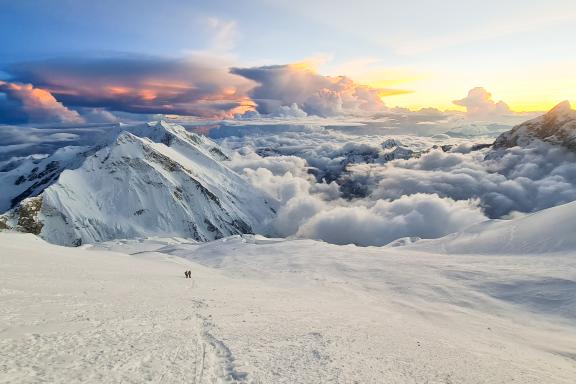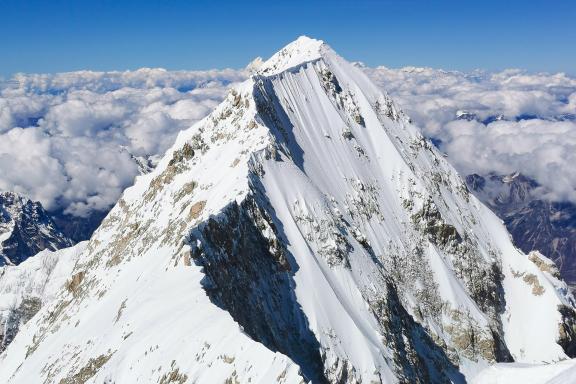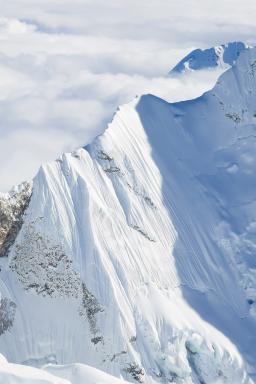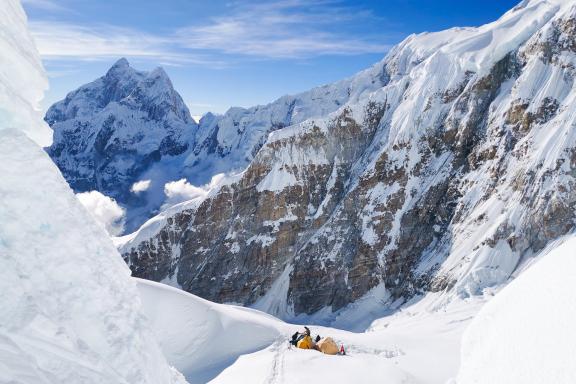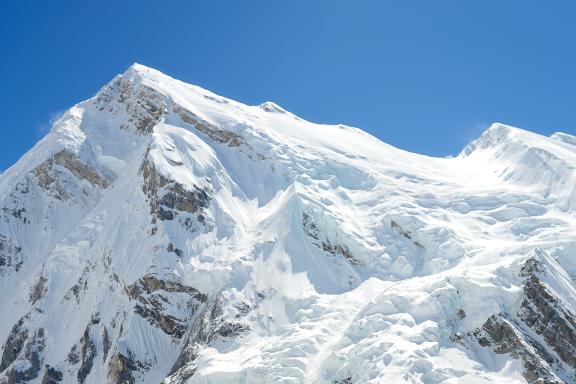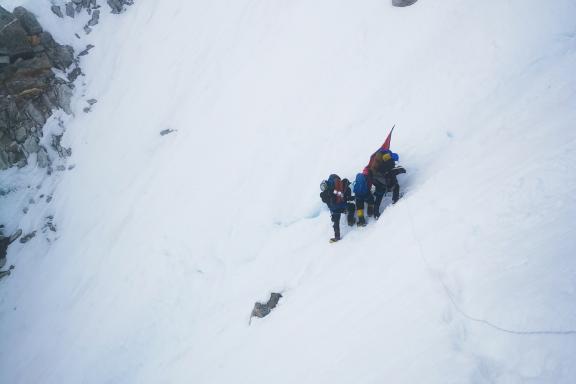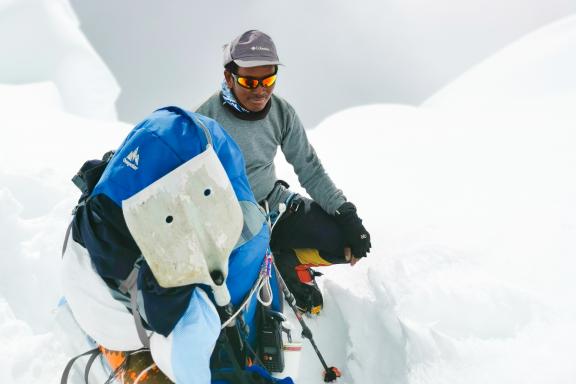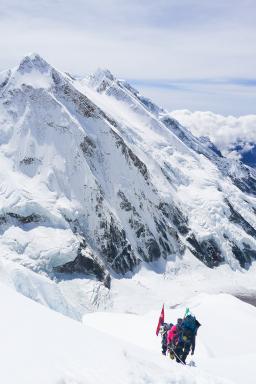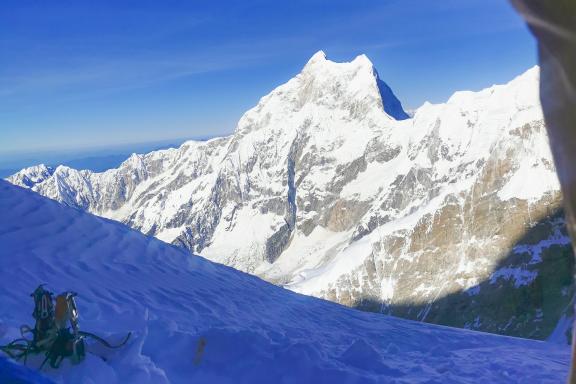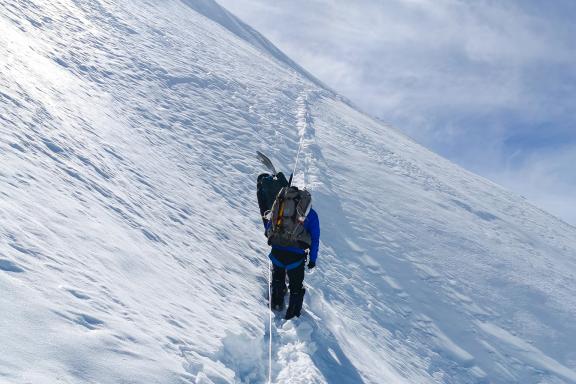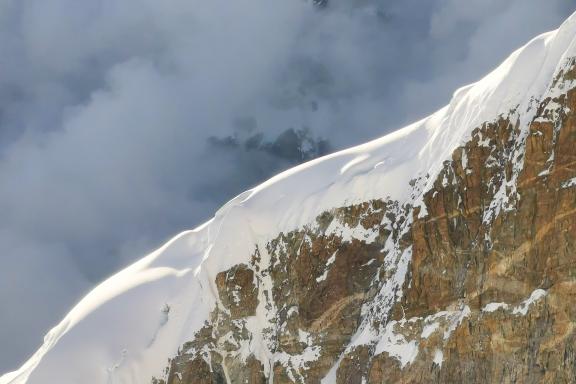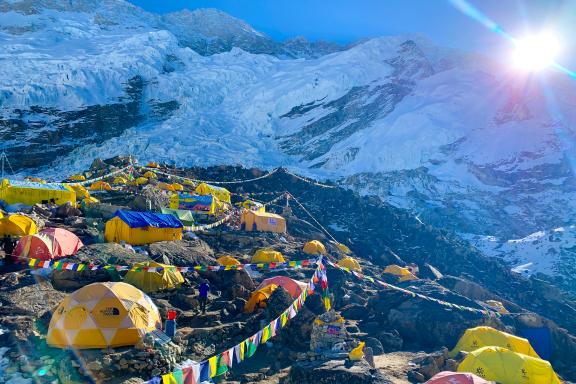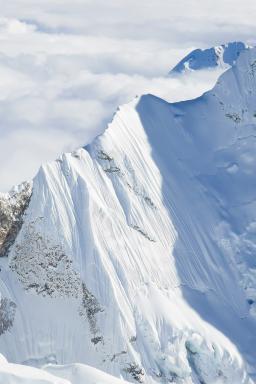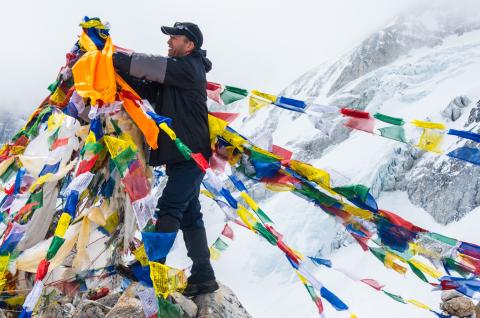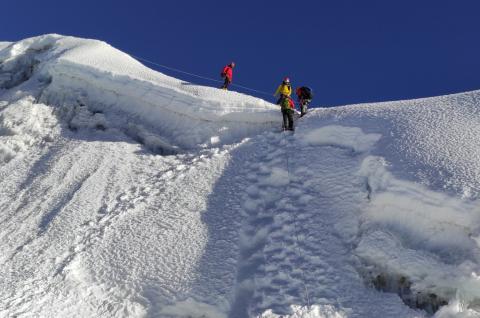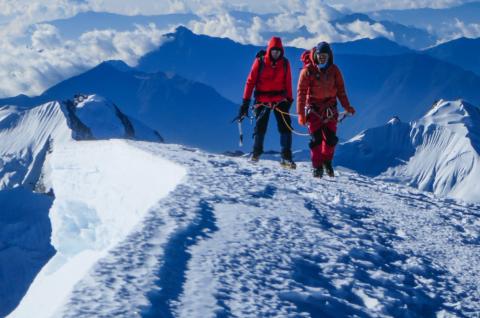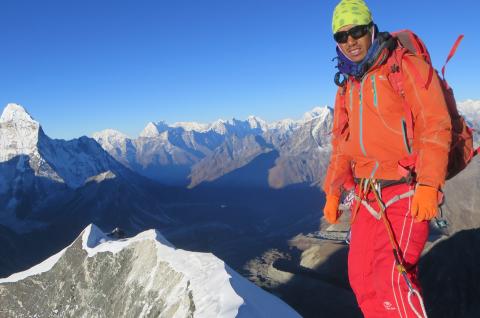One of the toughest 8000ers
Highlights
- Ratio of 1 sherpa to 1 participant
- Ascent with or without oxygen supply
- Experienced expedition leader
- Trekking access to base camp for acclimatization and team building
- Special care given to high-altitude food
- H24 personalized weather forecast services and medical hotline
- Preparation course, live expedition coverage
- Guaranteed departure from the first participant
Here we are on the slopes of Kangchenjunga, the third highest peak on the planet at 8586 metres, a real challenge for seasoned mountaineers. The route is very demanding and requires a great deal of experience at high altitude. In the event of bad weather, descending from the "Grand Plateau" back to base camp is no simple matter. The winds are often violent, hampering progress. The climb is very varied and presents a great deal of interest. It is one of the few summits at this altitude with rock-climbing passages. Success depends very much on the conditions of the immense Yalung glacier. Between 7100 and 5900 metres above sea level, the glacier descends in two great cascades of ice. Above this, what early climbers dubbed "the Great Shelf" leads to a large couloir. To reach the summit, a long ascent traverse with numerous rocky passages remains.
Overview
Kangchenjunga, 8586 meters. Its five different peaks earn it its Tibetan name: “the five treasures of the great snow”.
Kangchenjunga occupies a very special place in the hierarchy of 8000-meter peaks. Although not as high as Everest and K2, it can easily be compared in terms of difficulty with Nanga Parbat in Pakistan. Unlike the latter two summits, where the rocky difficulties are located in the lower third of the ascent, at Kangchenjunga, the greater the altitude, the greater the difficulties. They culminate in the last 300 meters of the summit pyramid. Here, you have to find the best route through snow- and ice-covered rock, and overcome tricky cracks that can't always be fully equipped with fixed ropes.
It took the legendary skill of British climber Joe Brown, roped up with George Band, to complete the first ascent on May 25, 1955. A rare occurrence in the Himalayas, he had to remove his crampons to cross the summit cracks!
Climbing Kangchenjunga, the third highest peak on the planet, is a remarkable challenge. The itinerary is very demanding, requiring a great deal of experience at high altitude. In the event of bad weather, descending from the “Grand Plateau” back to base camp quickly proves critical. The winds are often violent, hampering progress. Nevertheless, the varied ascent is of great interest.
Success depends very much on the conditions of the immense Yalung glacier. The glacier descends in two great cascades of ice between 7100 and 5900 metres above sea level. Above, what the first climbers dubbed “the Great Shelf” leads to a large couloir. What remains is a long ascent traverse in the summit pyramid, featuring the most technical rock passages.
Four camps are needed to climb this summit. Between the last camp and the summit, just over a thousand meters remain to be climbed in a single day, requiring 15 to 20 hours of effort.
Discover our animated itinerary of the ascent of Kangchenjunga.
MOUNTAINEERS' WORDS
These words from mountaineers on their ascent of Everest apply perfectly to our ascent of Kangchenjunga.
"What is it that makes this summit so fascinating to all mountaineers?... It is the highest mountain in the world... The many expeditions, the men who have conquered it, have not succeeded in making it smaller... The altitude remains." – Reinhold Messner
"We didn't have to wait for the ultimate vision. Above the fog, Everest was still before us...: motionless as Keats's star in its solitary splendor, and so high in the night! Eternal watchman of the shadows, the Mount seemed to inebriate the world with its radiance." - George Leigh Mallory
"Suddenly, it occurred to me that the ridge in front of us, instead of continuing to rise, was falling sharply; much lower down, I could see the North Col and the Rongbuck Glacier; in the foreground, a narrow snow ridge climbed towards a snowy summit; a few more ice axe strokes in the hardened snow... and we were at the summit. It was 11:30 a.m." - Edmund Hillary May 29, 1953
COLLECTIVE ADVENTURE
While it remains an exceptional adventure, the ascent of an 8000er is no longer an undertaking reserved for a very high-level alpine elite. Advances in logistics, mountain equipment, weather forecasting, gear and the physical fitness of mountaineers mean that the world's highest peaks are now accessible to technically autonomous, well-trained and highly motivated mountaineers.
Our expedition will be a collective adventure, a confluence of motivations and energies, a meeting of the capacities of an organization and motivated climbers. Two parallel challenges will have to be met:
- for the participants: to be physically, technically and mentally at the top of their game at all times;
- for the organizer: to provide irreproachable logistics enabling access to the high altitude camps under optimum conditions. Beyond that, it is up to the participants to play their part, taking part independently in the assaults on the summit ridge led by the guide and sherpas.
The main objective of this expedition is to experience an adventure that requires total commitment, both physical and moral, acting with lucidity and humility in a hostile natural environment that forgives no imprudence or temerity leading to death. It is this testimony that must be wisely remembered.
Good observance of all safety rules is essential, as is good physical and psychological preparation, a warm and supportive environment, total serenity, a little tactics and then, if the weather is kind and luck is on your side, you will be able to count down the magic minutes at the summit when effort ceases and nothingness fills the space and instills itself within you.
It is agreed by all parties that giving up is never a failure, but that accepting it can also be a victory over oneself. Any preparation, even the most meticulous, any will, even the most tenacious, can be defeated by the adversity of natural environments whose force is exponentially stronger than the finest human intelligence. Let the gods bless us and allow us to tread the summit.
THE MOTTO IS: DARE TO CLIMB, KNOW HOW TO DESCEND
VERY HIGH ALTITUDE
Advice from Hubert Giot, mountain guide. He has taken part in several expeditions to 8000 meters and climbed Everest without oxygen.
It is not easy to establish rules, because mountaineers are not equal when it comes to altitude, either physiologically or mentally. Everyone seems to have their own plateau where they get stuck. Extremely demanding, this stage is always painful, but not unmanageable. Once you are past this stage, everything's fine... or not so bad. It is generally at this point that you get a better idea of your ability to adapt. This can happen as early as 6000 meters, or even earlier, during the approach trek.
High altitude also has its own rules, and transgressing them becomes inherently dangerous. There is a fundamental difference between climbing to 8000 meters and descending immediately, and staying there for 12 or 24 hours.
At this altitude, the trouble really starts, and every minute spent up there leads to an inexorable process of self-destruction. We experience loss of sleep, lack of appetite, apathy and often hallucinatory phenomena.
In short... above 8000 meters, you are being consumed. For novices, anything is possible, just remember a few basic rules. The first few days at base camp serve as a thermometer, and by the third day you are often starting to feel good. It is then up to you to decide how to divide up the stages: either use the usual camp sites, or those defined by the terrain. As a general rule, when you can sleep at 6500 meters without headaches, you are ready to go higher. However, it is a good idea to make two return trips to 7000/7500 meters, to test your potential. During these essential shuttles, it is important to stay well hydrated. Now it is time to spend an often uncomfortable night at around 7500 meters, then attempt the summit at 8000 meters. If the summit is beyond that, we try to sleep at 8000.
As for the rest, you need to be prepared to use your brain (or what is left of it) rather than your muscles, because meters, beyond 8500 meters, are more costly. And if I say brain, it is because it has to be sufficiently alert to decide when to descend. If it does not, it is a sure death. Doing an 8000 in good conditions is hard, but with cold, wind, snow or a barometric depression, it turns into a nightmare.
As a general rule, here are a few precautions to take:
- don't get too cold ;
- don't get too hot ;
- cover your head ;
- stay hydrated, even in bad weather;
- try to have one hot snack a day;
- during the trek, do not walk bare-chested;
- at high altitudes, keep an eye on each other; don't doze off together;
- never descend alone;
- set limits for yourself, and look out for signs such as mirages, falling asleep and total loss of appetite;
- never hesitate to turn back, whatever the pressure;
- and in all cases, accept the fact that the mountains will always be there.
In short, to evolve at high altitude, you need meticulous preparation, adequate acclimatization, constant and mutual verification, intellectual vigilance at all times, and immediate renunciation in the event of weakness, doubt or danger.
Take a look at our web-conference on climbing Everest and Manaslu.
Itinerary
Day 0
- Day 1 & 2: International flights to Kathmandu
- Day 3: Flight Kathmandu — Bhadrapur — Ilam road — Kanyam
- Day 4: Road Kanyam — Suketar (Taplejung) — Trek to Lali Kharka (2800 m)
- Day 5: Trek from Lali Kharka to Sinchewa (2050 m)
- Day 6: Sinchewa — Mamankhe trek (1800 m)
- Day 7: Mamankhe — Bhotegaon trek (2000 m)
- Day 8: Bhotegaon — Lhamite Bhanjyang (3406 m) — Tortong (2860 m) trek
- Day 9: Tortong — Tseram (3700 m) trek
- Day 10: Tseram — acclimatization
- Day 11: Helicopter flight Tseram — base camp (5475 m)
- Day 12 & 13: Rest days at base camp
- Day 14 - 52: Kangchenjunga ascent — 38 days
- Day 53: Helicopter flight from base camp to Tseram (3700 m)
- Day 54: Tseram — Tortong (2800 m) trek
- Day 55: Tortong — Bhotegaon (2000 m) trek
- Day 56: Bhotegaon — Phomphe Danda (1740 m) trek
- Day 57: Phomphe Danda — Sinchewa Bhanjyang (1780 m)trek
- Day 58: Sinchewa Bhanjyang — Lali Kharka — Suketar (2740 m) trek
- Day 59: Suketar - Birmatod — Bhadrapur drive
- Day 60: Flight Bhadrapur — Kathmandu
- Day 61: Rest day in Kathmandu
- Day 62: International flights
- Day 63: Arrival in Europe
EXPEDITION DETAILED PROGRAM
Days 1 & 2: Europe – Kathmandu
Day 1
Flight from Europe to Kathmandu. Arrival is usually on Day 2. Welcome by our local team at the hotel and free time.
Day 3: Kathmandu – Bhadrapur – Ilam – Kanyam
Day 3
One-hour flight to Bhadrapur. Then a 4-hour drive to Ilam and its tea plantations and on to Kanyam and its tea gardens.
Day 4: Kanyam – Suketar (Taplejung) – Lali Kharka
Day 4
Day 5: Lali Kharka – Sinchewa
Day 5
We descend, across fields, to the Gurung village of Thambewa at 1880 meters, a short climb over a ridge before a steep descent that takes us to the banks of the Phawa Khola at 1430 meters, which we cross on a suspension bridge. A long climb lies ahead. After the village of Khunjuri, we reach a pass and then Bhanjyang, on the crest, at 2750 meters. First view of Kangchenjunga and Kabru.
Day 6: Sinchewa – Mamankhe
Day 6
Starting today and continuing for two days, we head due north-east along the Kabeli Khola. The trail alternates between ascents and descents, passing by waterfalls, through the villages of Phun Phun, Phonpe and around the left-hand ridge of chortens and prayer flags, before a final climb takes us to Mamankhe, a prosperous Limbu village.
Day 7: Mamankhe – Bhotegaon
Day 7
A difficult day, always on steep, sometimes rocky paths. We cross numerous streams on foot and then arrive at Yamphudin (1690 m), at the confluence of the Kabeli and Omje Khola rivers. The village, surrounded by corn and rice fields, was partly washed away by the monsoon a few years ago. Interesting mix of populations: Rai, Limbus, Gurung and even Sherpas. We continue to the Tibetan village of Bhotegaon.
Day 8: Bhotegaon – Lamite Bhanjyang (3406 m) – Tortong
Day 8
The climb begins in barley fields, then meadows, before tumbling down through the forest. The vegetation is dense with orchids, bamboo and rhododendrons, interspersed with tiny clearings visited by occasional lumberjacks. On the ridge, with a little luck, you will be able to make out the head of Jannu (7710 m) before crossing the Simbua Khola and reaching the village and caves of Tortong, on the banks of the Simbua Khola.
Day 9:Tortong – Tseram
Day 9
We follow the right bank of the Simbua, which flows out of the mighty glaciers clinging to the walls of Jannu, Kabru, Talung and, of course, the south face of Kangchenjunga. All day long, the views are sumptuous in this valley frequented only by shepherds and their herds of yaks. We are now in sight of the front moraine of the Yalung glacier, dominated by Kabru (7353 m) and Talung Peak (7349 m).
Day 10: Tseram
Day 10
Rest day for acclimatization.
Day 11: Tseram – Kangchenjunga base camp heli-flight
Day 11
A helicopter picks us up in Tseram and takes us directly to base camp, avoiding the long ascent of the moraines beyond Tseram.
Days 12 & 13: Acclimatization days at base camp
Day 12
These days are essential for resting from the fatigue of the approach trek and taking the measure of the challenge that awaits us.
Days 14 to 52: Kangchenjunga ascent (8586 m)
Day 14
Difficulty level: AD for the whole route, but significant objective dangers, reinforced in case of bad weather. AD+ for the steepest sections between camp 4 and the summit.
The ascent requires the installation of four altitude camps.
- Base camp: 5475 m on the Yalung glacier
- Camp 1: 6,200 m
- Camp 2: 6400 m
- Camp 3: 7100 m
- Camp 4: 7550 m
This itinerary follows the original route taken by British mountaineers in 1955. It is divided into three distinct sections.
The long ascent of two successive icefalls between 6000 and 7000 meters altitude – (camps 1 to 3).
The ascent of the large plateau to the foot of a large couloir under the west ridge – (camp 4).
The ascent of the large couloir, followed by a long traverse upwards to the right, in the rocks under the west ridge, to reach the summit. This third part of the ascent presents some of the trickiest passages, as you climb the rocks below the summit.
The route is also exposed to avalanches, both in the ice cascades and on the large plateau above which the imposing West Face rises.
From base camp (5745 m) to camp 1 (6200 m)
Above base camp, the route begins by climbing 45° slopes along a rocky spur. We reach the foot of the first icefall. The slope rises again and leads to the summit serac, which must be crossed on fixed ropes. The camp stands on the flat at the exit of the serac.
From camp 1 to camp 2 (6400 m)
Descend +/-200 m to reach the main glacier and the second icefall. Approximate distance on the glacier: 1.5 kilometer. But the route depends very much on the state of the crevasses. Camp 2 is set up at the foot of the second icefall.
From camp 2 to camp 3 (7100 m)
Long progression between crevasses and seracs to reach the “Grand Plateau”. The difficulty of the route varies greatly from year to year, depending on the state of the glacier. The seracs form a sort of giant staircase. The steepest passages are equipped with fixed ropes.
Camp 3 to Camp 4 (7550 m)
A long, easy climb up the huge combe that forms the “Grand Plateau”. The initial 15° slope gradually rises to 45° before the camp.
Camp 4 to summit (8586 m)
The thousand meters separating the last camp from the summit present the most delicate passages, and it is not always possible to equip them entirely with fixed ropes. The route begins by ascending the large couloir to around 8250 meters, on 45-50° snow slopes. The couloir forms a “Y”. Take the right-hand branch for an ascending traverse that leads to the foot of the steep rocks (8380 m). Several III+ passages allow you to overcome various walls. The first climbers have taken off their crampons to be more comfortable on the rock. We join the west ridge near a gendarme (8450 m). Climb a short snow ridge and traverse right to a chimney (8500 m), a key passage for the first ascenders. A few more meters of traverse, and a final snow slope leads to the summit.
Given the complexity of the face, several routes are possible on this last part of the ascent.
Because of the difficulties encountered on this last section, here even more than elsewhere, you need to save your strength for the descent. The most difficult sections must be abseiled. In bad weather, the route becomes even trickier.
Recommended timetable: departure around 10 pm, summit around 9 am; ideally, you should be back at camp 4 by 4 pm, but most of the time you will be back in the tents by 6 pm.
Day 53: Base camp – Tseram heli-flight
Day 53
Helicopter transport again to reach the trekking route to the lower valleys, avoiding the tedious descent into the moraines.
Day 54: Tseram – Tortong trek
Day 54
We begin our descent along the Sambuwa Khola.
Day 55: Bhotegaon – Phomphe danda
Day 55
We head straight for Mamankhe on a balcony trail that passes through a few hamlets with simple houses, mostly built of bamboo and decorated with tropical flowers. We are starting to descend, and the heat, even as winter approaches, is still quite oppressive. After lunch, we cross the Pauwa agrarian plateau, before finishing the day with a zigzag climb through the forest to land at the Phomphe Danda camp.
Day 56: Bhotegaon – Phomphe Danda
Day 56
We reach Mamankhe directly via a balcony path that passes through a few hamlets with simple houses mostly built of bamboo and adorned with tropical flowers. We start to descend and the heat, even as winter approaches, is still quite oppressive. After lunch, we cross the Pauwa agrarian plateau, before finishing the day with a zigzag climb through the forest to land at the Phomphe Danda camp.
Day 57: Phomphe Danda – Sinchewa Bhanjyang
Day 57
Day 58: Sinchewa Bhanjyang – Lali Kharka – Suketar
Day 58
It is our last day of trekking, and still through the countryside. All the villages are served by a track, but we will take the inter-village paths to Lali kharka, before tackling the last big climb through the forest to cross the Deorali pass at 2600 meters.
Day 59: Suketar – Birtamod
Day 59
At dawn, it is not long before we are off, as it is a long way to the Terai plains.
Day 60: Birtamod – Bhadrapur – Flight to Kathmandu
Day 60
Transfer to Bhadrapur airport for a 1-hour flight (as on the outward journey, a real “mountain flight”) to the capital Kathmandu, around midday. Afternoon and evening at leisure.
Day 61: Kathmandu
Day 61
Free day (can be used as a contingency day if the day-by-day trek is delayed).
Day 62: Back to Europe
Day 62
Transfer to Kathmandu airport according to international flight schedule.
Day 63: Arrival in Europe
Day 63
END OF EXPEDITION
For reasons that cannot be foreseen at this stage, such as unpredictable weather, the physical fitness or lack of fitness of participants or other circumstancess (customs formalities, road conditions, traffic, landslides, force majeure, etc.), your expedition leader may have to adapt the program, if necessary, to ensure the smooth running of your trip. He remains the sole judge and the one who guarantees your safety. Activity times are given as an indication and may vary from one participant to another.
The itinerary for all our expedition programs, or the ascent program for our high-mountain expeditions, are given here as a guide only. They are flexible enough to adapt to weather conditions with a few contingency days. In any case, you should follow the recommendations of your guide, who may suggest that you cancel your expedition due to weather, safety or physical conditions.
It is important to remember that this is a truly unsupported expedition, and that anything can happen. Expeditions Unlimited, your expedition leader, your guide or our local teams can in no way be held responsible.
Any costs incurred as a result of a change in the expedition schedule (extra nights' accommodation, extra flights) will be borne by the participants and not by the organizers. "Contingency days" refer to the expedition in the strict sense of the term (base camp/base camp in the mountains, departure point/exit point on a traverse, etc.).
Any early return of the expedition or of certain members only (early success, abandonment, etc.), generating costs for accommodation, meals, changes to air tickets or other activities not provided for in this program, will be charged in full to the participants.
Trip notes
Guiding
YOUR PRIVATE GUIDE
Key to your success on all our expeditions, we systematically use a ratio of one high-altitude sherpa per participant. He accompanies you during the key moments of the ascent and during the summit push. He is particularly experienced at high altitude. We select him for you. He generally speaks English. He may not be with you all the time during rotations between camps, as his role is also to manage the carrying operations to set up the camps.
A summit bonus is also arranged for your high-altitude sherpa, to be paid in cash on site after the ascent. This bonus is due from the moment you leave the last summit camp on your summit push attempt.
Our team of "altitude sherpas" can be made up of several Nepalese ethnic groups, Sherpa of course, but also Tamang, Gurung, Rai, Bothe, etc.
EXPEDITION LEADER
The expedition leader plays an important role in setting up the logistics of the upper camps and implementing the strategy required for success: rotation in the high altitude camps, acclimatization of each participant, study of weather reports to decide on the optimum moment to launch the summit push.
The expedition leader represents Expeditions Unlimited to the group, our partners and local authorities. Mainly based at base camp, he may accompany you to the high altitude camps to oversee the logistics of the expedition. He takes any necessary decisions. His authority is absolute and undeniable. You must respect his decisions, as well as those taken collectively.
From one to five participants, you have a local English-speaking Nepalese expedition leader who has coordinated numerous expeditions over 8000 meters. He can be shared with other expeditions.
For groups of six participants, an experienced French expedition leader is assigned exclusively to your expedition.
LOCAL TEAM
For a project involving the ascent of a major Himalayan peak, our team is particularly well-staffed to deal as effectively as possible with the two key issues of an expedition: technical supervision and the carrying of equipment (food, collective and personal equipment). This is an important issue, as it directly affects the success of both parties. As a result of more than 10 years of joint reflection and work, our operation is fully optimized and the tasks entrusted to each person determine their own status. determine their own status.
A base camp manager and kitchen staff will be present at base camp. A cook will be present at Camp 2.
There is a team of porters who help us set up base camp with all the equipment and cooking facilities. Beyond that, the team of high-altitude sherpas takes over. In particular, they help us to set up the high altitude camps and with the carrying from base camp.
Each participant is responsible for carrying his or her own personal belongings and high-altitude food. Collective equipment is carried by the Nepalese team. Our rucksack will weigh between 10 and 12 kg.
And throughout the program, we will rely on other local skills as needed. Finally, we will have access to personalized weather forecast services and a specialized high-altitude doctor from Ifremmont (see above).
For unpredictable reasons at this stage, like adverse weather conditions, insufficient physical condition of participants, insufficient competencies of participants related to the intended activities, your guide may decide to adjust the intended program and/or activities. At all times, his decision will be final on all matters likely to affect the safety and well-being of the trip.
Difficulty level
Level rated: extreme
This program is intended for experienced participants, who have a high level athlete's physical and mental condition.
It is rated as “extreme difficulty” because of the very high altitude at which you will be climbing. Kangchenjunga is one of the highest mountains in the world, and presents real technical difficulties. Climbing it is a difficult and sometimes even dangerous undertaking. Attempts to reach the summit involve a high degree of commitment.
This expedition is therefore designed for experienced mountaineers (comfortable at AD+ level in snow and rock). It is essential to be totally self-sufficient in the mountains, both technically and psychologically. The expedition leader and guides are primarily technical advisors and logistics managers. Under no circumstances can they "pull" a participant towards the summit.
Rigorous training is of course essential, focusing on developing endurance and stamina: running, cycling, swimming, cross-country skiing and, of course, mountain climbing. This training must be regular and begin at least 6 to 8 months before the start of the expedition.
Preparation will continue to be carried out in constant liaison with the organizer and guide. Particular attention will be paid to safety and the management of high altitude hazards.
High altitude is, of course, the major problem we face. The process of oxygen deficiency (hypoxia) is at its peak when climbing a peak such as a 8000er. Progressive acclimatization is essential to offset this phenomenon as much as possible. During the first few weeks, you need to take it easy, avoid violent efforts and go at your own pace. Although "secondary" symptoms such as migraines and nausea are virtually unavoidable in the early stages, be careful not to ignore them, as they can trigger an oedematous process.
For a relatively long period of time, the body will be subjected to considerable physical effort in a difficult environment, with the added handicap of high altitude. Serious physical preparation is essential for an expedition of this scale: you will need to work on your stamina and endurance, even in difficult climatic conditions (cold, wind).
It should be noted that we offer climbers who wish to do so the opportunity to attempt an ascent without oxygen in order to reach the summit. Most will take supplementary oxygen from Camp 4 (7550 m). The organization, and in particular the "1 altitude sherpa for 1 participant" ratio during the summit push allows us to ensure slightly different and personalized ascent rhythms. Don't hesitate to discuss this with us.
Beware of carrying: while collective equipment is carried by the sherpas, personal belongings must be carried during the ascent; not doing so at all would be highly detrimental to summit attempts, during which a bag of some weight must be carried, since it will have to contain oxygen cylinders.
On an expedition, participants are confronted with a hostile environment due to its remoteness, cold, bad weather and discomfort, all of which can generate stress. Fatigue can be the cause of mood and relationship disorders. Everyone must therefore show good mood, tolerance and respect, not only towards the members of the expedition, but also towards the local team. The group may split into sub-groups according to individual affinities. Keep in mind that it is the core team that prevails and that, as always in this type of project, the key to success remains the collective and team spirit.
Therefore, participation in the preparation course, the date of which will be specified later, is mandatory. In addition, mountaineering preparation courses as part of our Adventure School can be a serious asset, both to build confidence and to gain autonomy.
To register for this expedition, you will be asked to provide an expedition (mountain climb list)/trek/athlete CV. A hypoxic stress medical test is also mandatory, as is a medical certificate for completing an ascent in the Himalayas.
You benefit, free of charge and for the duration of your expedition, from membership in the 24/7 high altitude medical service set up with our partner Ifremmont, of which we are partners. See below.
If you have any health problems that you feel could compromise the success of your expedition, please let us know so that we can assess together whether they are compatible with this expedition. And we strongly advise you to have a check-up with your dentist before departure, given the length of the expedition and the significant variations in altitude and pressure.
Last but not least, we can provide you with a sports coach and/or a mental coach for the months leading up to your expedition, to help you prepare in the best possible conditions. We have developed remote protocols in this field, just as we have built a hypoxia preparation protocol which we describe later in this document in the chapter devoted to Ifremmont.
In the longer term, we offer refresher and advanced mountaineering courses as part of our Adventure School, as well as expeditions to peaks at 5000, 6000 and 7000 meters, offering you the ideal progression towards your dream goal at very high altitude.
Technical difficulty
Mountaineering level: fairly difficult (AD+)
In this program, the use of mountaineering equipment (crampons, harness, ice axe, ropes, etc.) is necessary, and the route tackled can involve minor difficulties, whether it's slightly steeper passages in a glacier section, the height of the wall, the commitment of the climb or the continuity of effort. Of course, altitude makes everything more difficult. Steep or more arduous passages are all equipped with fixed ropes, so you need to be comfortable with a self-locking handle in all situations. This climb is aimed at participants with previous mountaineering experience and who have already completed climbs of this level.
This technical rating applies, of course, to normal weather conditions: difficulty can increase in poor conditions, with fresh snow for a rocky route, insufficient or poor-quality ice for a glacial route, etc., and the situation can change radically if the weather is not too bad. Similarly, the situation changes radically, for the same technical level, with altitude, the weight of the rucksack, the lack of equipment for the route on site, the fatigue linked to the approach if it is long, the particularly hostile environment, and so on.
Our École de l'Aventure's three- to five-day mountaineering courses are for you, and are the perfect way to make sure you're at the right level.
Meeting point
We meet up in Kathmandu and are welcomed at the airport by our local teams.
Given the diverse origins of the participants on this trip, international outward and return flights are not included in this package. In most cases, we book flights on your behalf to ensure that the whole group arrives at the destination at the same time. We do not charge any fees for these air bookings. Please do not hesitate to contact us. If you book your own tickets, we will advise you on the ideal flight schedule to enable all participants to arrive within a reduced time frame. At the very least, you need tickets that can be modified.
Accommodations
KATHMANDU AND TREKKING
In a single room in a 3/4-star (***) hotel accommodation in Kathmandu.
During the trek, we will be staying either in individual tents or in lodges. Lodges in Nepal are of very random comfort. Lodges can resemble a refuge or sometimes our local B&B. Most are family homes with double, triple or dormitory rooms. Toilets and showers are always separate. It is important to check that the water is not heated with wood, as this contributes to deforestation. Most of the time, water is heated with solar energy.
BASE CAMP
At base camp, we stay in individual tents.
As a base for several weeks, it needs to be as comfortable as possible, to enable us to recover properly on our return from the altitude camps. It should also enable us to cope with periods of bad weather in the best possible conditions. Each participant has his or her own individual tent with a comfortable mattress. A heated mess tent is the main living area. Tables and chairs are permanently installed. We also have a shower tent and a toilet tent (solid waste is disposed of in drums).
HIGH ALTITUDE CAMPS
During the ascent, at the altitude camps, we have an altitude tent for 2 people, and even 3 people at the last camps.
Hygiene & laundry
Toilets: The base camp is equipped with toilets and toilet paper. Make sure you wash your hands with a hydro-alcoholic gel (available from your personal pharmacy) after each use of the toilet. For the higher camps, we recommend that you take a bottle with you to urinate in at night, to avoid having to go outside.
Daily hygiene: a basin with soap and water is available at the entrance of the mess tent. Water for washing hands and face; do not drink.
Showers: hot water available (request from kitchen). Showers should only be taken on sunny days to avoid catching cold!
Laundry: (cold) water and basin to be requested from the kitchen. Bring biodegradable products only.
Meals
KATHMANDU AND TREKKING
On arrival in Kathmandu, a welcome dinner is offered on the first evening. Similarly, on your return from the expedition, a farewell meal is provided.
In the towns, there are many small (and large) restaurants where you can sample typical local cuisine. With the exception of Kathmandu, breakfasts and evening meals are prepared by the lodge's kitchen staff or cooks and served in the lodge's dining room or mess tent. Depending on the profile of the stages (length of the day's walk and/or presence of water), midday snacks will be served hot or cold in the form of picnics.
BASE CAMP
All meals are prepared by the kitchen staff using local ingredients, including rice, pasta, lentils, potatoes, vegetables, eggs, a little meat, etc. They are served in a private tent. Hot non-alcoholic beverages such as tea and coffee are provided free of charge. We recommend that you stay hydrated at all times.
HIGH ALTITUDE CAMPS
At altitude, you often have to force yourself to eat. The use of freeze-dried food is almost unavoidable. But such dishes, appetizing in the valley, quickly become a source of disgust in high altitude camps. During the preparation course, we bring a sample of lyophilized dishes for you to taste, to indicate your preferences, which we do our utmost to respect (depending on the stocks available at the time of final purchase). You can also bring along a few of your favorite dishes (if you have any)or small snacks that give you pleasure (cold meats, cheese, etc.), or energy bars as the ones on offer locally are sufficient but basic, and so on. Be careful with the weight – we are talking about a kilo in all!
Each tent has a stove for melting snow (MSR Reactor type) and making water for freeze-dried food and hot drinks. The necessary gas cartridges are supplied.
HYDRATION
Take along tablets (such as Hydroclonazone, Micropur or others) to disinfect the water you put in your water bottle, depending on the source and on the advice of your guide. It is sometimes possible to buy purified water and fill your bottle without having to buy bottled water. You can also buy "mineral" water in the towns (not included in the price), but as you know, it has a poor environmental performance. So we do not recommend it.
Besides, glacier meltwater contains no mineral salts, which is partly compensated for by the soups and other meals you' will be eating. But if you only drink tea or coffee made from glacier meltwater, or just water in your water bottles, over a long expedition, you will hydrate less well, risk gastric problems and, ultimately, deficiencies that will tire the body. To counter this problem, it is a good idea to pack mineral tablets in your luggage at some point, to supplement your water bottle. Two or three tubes of ten tablets are all you need.
Transfers / Transport
All transfers are by private vehicle.
For various reasons, we prefer trekking to reach Tseram, before making a short helicopter transfer to base camp: the progression designed for acclimatization allows us to prepare ourselves physically and psychologically for the ascent. It's also the ideal time to get to know the team and start building a sense of group spirit and cohesion.
The return trip is by helicopter to Tseram, then by trek. This being said, the possibility of taking the helicopter on the return trip is available at an additional cost.
Group size
The group is composed of 1 to 10 participants maximum. The number of participants is deliberately limited to allow for greater immersion, to avoid embarrassing our hosts, and to develop freedom and flexibility. However, the maximum number may be exceeded if the last person to register wishes to travel with one or more other people. The services will not be modified, and the conditions of the trip will remain the same.
Equipment
COLLECTIVE EQUIPMENT
All logistical equipment is provided, including individual tents at base camp with mattresses, mess tent, shower tent and toilet tent, as well as all collective and individual cooking equipment. At altitude, tents, stoves with gas cartridges, ropes and anchors.
INDIVIDUAL EQUIPEMENT
Personal equipment is not provided. A full list is given later in this document. It will be refined with us during the preparation course and up to the moment of departure, depending on your questions.
High altitude sleeping bags, full-body down suits and/or good-quality down jackets are expensive items that you may not use frequently. We can rent you this specific equipment for the duration of the expedition. You must then return the equipment cleaned and in the condition in which it was given to you (deposit required). The rental price will be communicated to you on request. The cost of transport remains your responsibility, unless you pick it up at the agency in Lyon.
OXYGEN OR NO OXYGEN
For safety's sake, high altitude sherpas always use oxygen, even at reduced flow rates.
The vast majority of participants in all Annapurna expeditions take oxygen from Camp 4 (7550 m). We therefore include in your package the oxygen supply from camp 4, i.e. three cylinders, a regulator and an oxygen mask for you. The cylinders and the equipment needed to use them are transported to the altitude camps by the altitude porters.
If you wish to use additional oxygen before camp 4, you will need to ask your expedition leader and/or sherpa as soon as possible during your expedition, and additional cylinders will be charged extra. Oxygen cylinders not included in the package must be paid for on site.
That said, we are one of the few organizers to allow our participants to attempt the summit without supplemental oxygen. Our experience has shown us that this is definitely possible. The organization, and in particular the ratio of “1 high-altitude sherpa to 1 participant”, allows us to ensure slightly different and personalized ascent rhythms. We can also have participants in the same group who require oxygen and others who do not.
If you choose to attempt the climb without the use of oxygen beyond Camp 4, then you need to talk to us as soon as possible to fine-tune your acclimatization. Your choice will depend on the agreement of your expedition leader and/or your sherpa, who will assess your fitness during the first rotations.
Please note that if you choose not to use supplemental oxygen for your ascent, no refund will be given. For safety reasons, one oxygen cylinder per participant is provided at Camp 4, whether you use it or not.
You then have two options, starting from Camp 4 (7550 m) during the summit push:
- You don't need an oxygen cylinder: the "purist" option par excellence. It allows you to move forward without adding extra weight (4/5 kg). But if you become too tired or slow, you have no option but to turn back, whether your sherpa tells you to or not, and return to Camp 4. The summit attempt is over, there will be no more.
- You take at least one oxygen bottle with you if you need it to complete the climb: it means extra weight in your rucksack (4/5 kg), and it is up to you to use it or not, at any point during the summit push.
SECURITY AND COMMUNICATION
We have a minimum of one Iridium satellite phone for the group, which is used for logistical, weather and safety purposes only. Under certain conditions, participants may make use of it. For private use, please contact us.
The camps will be permanently linked by radio. Expedition leader, participants and high-altitude sherpas will also be able to use them.
The expedition will have a hyperbaric chamber at base camp, and a full pharmacy, though lighter, at the upper camps.
The group will be equipped with a Garmin Inreach beacon, enabling you to communicate freely and without restriction with your friends and family, wherever you may be on the mountain, as well as sending tracking and safety information. It is on this beacon that you will receive weather forecasts and that we will communicate together regularly.
At the same time, we will provide live coverage of the expedition for the general public, including a logbook and photographs, enabling you to share your adventure with your community. To this end, and if the base camp is not equipped with wifi or 4G, you can also use an IridiumGo system to send your photos. These systems are simple to use, but require a few tests before departure, which we will carry out together.
In addition, at the time of writing, all participants are free to bring any systems they have. We just need to be able to declare them to our contacts, so please let us know in advance.
Please note: in order to preserve the serenity of this expedition and the privacy of the participants, we ask you not to communicate with the general public during the expedition. You are, however, free to send information about yourself to your private sphere. By registering for this program, you accept this essential clause to protect the privacy of other participants in a project of this scale, where important issues of image, physical risk and financial considerations (sponsors, etc.) are at stake.
Our commitments to sustainable development
Our commitment to a better planet has been a reality since the beginning of our story but we always need to do more and better. Please find out more about our charter and our commitments in terms of sustainable development. We have drafted our charter and take action through six themes on which we act as concretely as possible, most often with you: social equity and cultural respect, preservation of water, waste management in expedition, protection of biodiversity, raise public awareness on these subjects and finally, the optimization and recovery of CO2 emissions.
Regarding carbon emissions, most of which are due to air travel, we calculated and communicated in 2018 on the carbon footprint of each of our programs, expressed in tonnes of CO2.
These calculations made us aware of the importance of the total carbon emissions generated by our activity. Also, we have committed in 2022 to a carbon reduction that we believe is unprecedented in the tourism industry, aiming to reduce the total emissions of our activity by 5% per year, taking 2019 as the reference year (3,430 tonnes of CO2). This commitment is in line with the trajectory of the Paris climate agreements of 2015, the current benchmark. Thus, in 2030, we commit ourselves not to exceed 2,160 tonnes of C02. Thus, our maximum “carbon” budget for 2024 is 2,950 tonnes and for 2025, this budget will be reduced to 2,800 tonnes. And so on until 2030. To find out more about all of our calculations and our commitments in terms of reducing our carbon emissions.
In addition, since 2019, we have been encouraging you when you book for your journey to contribute with a donation to an independent NGO, among the two we have selected that share the commitments made in our charter. We matched the amount of this donation to this program's carbon footprint. Thus, the journey you are considering generates 3,82 tons of CO2, which corresponds to a 100% donation of €115 for an estimated value today of €30 per tonne of CO2. This donation remains of course optional and you can decide to give between nothing and 100% of this amount. Since 2019, including covid years of 2020 and 2021, we have been able to collect thanks to you nearly €7,000 for these associations.
Please do not hesitate to come back to us with any questions you might have regarding this carbon footprint mechanism, our other sustainable développement commitments or even to share with us your experience through a chat or a mail at contact@secret-planet.com.
Expedition leader
We rely on the most experienced high altitude expedition leaders. They are part of our close community and co-opt each other. They know each other well and respect each other.
For this expedition, the expedition leader has not yet been formally appointed, but should be shortly.
In addition to their exceptional expeditions experience, our expedition leaders have the know-how to optimize the expedition's chances of success, both in terms of group management and in terms of the pace at which the group builds up its strength and progresses in altitude, key elements in this type of expedition.
Departures and pricing
Please find below all dates and prices for this expedition. Prices are quoted "from" and may be adjusted notably according to the number of participants (see trip notes for details). Please note that dates and prices for years beyond 2024, when given, are for guidance only and are subject to change and readjustment to take account of current economic realities.
No date works for me!
I initiate a new datePrice includes
- Welcome dinner on arrival in Kathmandu
- 3/4-star (***) hotel accommodation in Kathmandu with breakfast, single room for three nights
- Airport/hotel transfers in Kathmandu
- Domestic return flights Kathmandu/Bhadrapur
- Private bus transfers between Kathmandu and the trekking departure/return point
- Helicopter return flights between Tseram and base camp
- Full-board accommodation in lodges during the acclimatization trek
- Base camp food supply
- Accommodation in tents during the trek
- Carrying of personal belongings during the acclimatization trek
- Equipment required for life at base camp: fully-equipped kitchen tent, mess tent for meals with heating and solar lighting toilet tent, shower tent, table and chairs.
- A cook and his assistant at base camp
- At base camp, one tent per person, with mattress, pillow and solar lamp
- High-altitude tents, high-altitude food, stoves and fuel
- Insurance for altitude guides (evacuation, hospitalization, medical expenses, life insurance), for the cook and his helpers
- Experienced French mountain guide from 6 participants.For less than 6 participants, the expedition leader is Nepalese, and his mission can be carried out by one of the most experienced Nepalese altitude guides (see below)
- Local mountain guide (sirdar) with extensive experience in managing local teams
- Logistics manager and local manager at base camp, highly experienced guide and instructor
- 1 Nepalese altitude guide for every 1 participant, he carries food and equipment to the high- altitude camps and supports you on the final ascent
- 3 oxygen cylinders with mask and regulator per participant
- 1 oxygen cylinder with mask and regulator per altitude local guide
- Collective equipment required for ascent (fixed ropes, moorings, etc.)
- Equipment allowance, fees, tent and food for cook and helpers
- 1 satellite telephone at advanced base camp (for rescue purposes only)
- 1 walkie-talkie for every 1 altitude guide in connection with base camp and Camp 2
- Solar panels at base camp for charging small electronic equipment (such as cell phones and cameras). Not sufficient to charge computers
- Taxes and climbing permit, rope fixing fee, all government environmental taxes and garbage deposit
- Personalized weather forecast services
- Medical follow-up by Ifremmont during the expedition (see above)
- Preparation courses (practical, medical)
- Live coverage of the expedition for your community (supply of InReach beacon, IridiumGo and subscriptions, LivExplorer service configuration)
Price does not include
- International flights to and from Kathmandu
- Consular fees (visa)
- Any customs taxes upon arrival in Nepal
- Import taxes, if any, for satellite phones, professional communications equipment and commercial film shooting
- Any additional hotel nights in Kathmandu (over 3 nights)
- Meals in Kathmandu other than breakfasts, welcome meal and farewell meal
- Expenses related to the early return of the expedition or of certain members only (early success, abandonment, etc.), generating costs for accommodation, meals, changes to air tickets or other activities not provided for in this program
- Expenses related to a shift in the expedition schedule (extra nights' accommodation and meals, additional airfares)
- US$1,000 summit bonus for your altitude guide, to be paid on site after the ascent (whether the summit is reached or not)
- Tips for the local team, 400 US$/participant
- Any personal communications by satellite phone (to be paid locally)
- Personal equipment, including individual high-altitude gear
- Rental of personal high-altitude equipment, subject to availability
- Any additional oxygen cylinders (approx. US$500, to be paid locally, subject to availability)
- Pre-acclimatization protocol developed with Ifremmont and physical and/or mental preparation with a specialist Sport Altitude coach as described above
- Drinks and personal expenses (sightseeing, cabs, souvenirs, dry-cleaning, etc.)
- Travel and expedition insurance (assistance, evacuation and repatriation)
Your custom expedition
We put our expertise, our knowledge of the terrain, our creativity, our experience, the quality of our guides and the reliability of our partners at your service to build your custom expedition. We can also personalize an expedition to your wishes as soon as you form a "closed" group, whatever the number of participants.
This means that, unless you authorize us to do otherwise, no outside participants join you, and we can personalize your expedition by adapting it to your own pace, with the program extensions you desire, a higher level of comfort, certain activities, other encounters, etc.
Every expedition of this type is subject to a specific quotation. To get in touch with us now, please fill in the short questionnaire below. One of our experts will get back to you to refine your request and make you a proposal.

